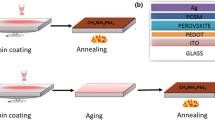Abstract
Perovskite solar cells have shown rapid development in efficiency since it was first produced. As a result of this development, efficiency values have reached ~ 25%. However, their efficiency decreases significantly after production. This decrease in efficiency values is called degradation or instability. Determining the source of this degradation in perovskite solar cells will also provide information on the solution of the degradation problem. For this reason, it is necessary to examine the layers that make up the perovskite solar cells separately under different aging conditions and to determine which layer or layers play an active role in the degradation. In this study, two different dopant ratio PEDOT:PSS films were produced with solution base deposition. PEDOT:PSS film’s electrical conductivity changes and electronic defect states changes were determined under different atmospheric aging conditions such as laboratory atmosphere, UV aging, oxygen aging, and light soaking. Depending on these aging procedures, dark conductivity values depending on time and photoconductivity values depending on flux were recorded. Mobility-life time calculations were performed from the photoconductivity values. In the light of the obtained results, the pedot:pss film which would exhibit a more stable performance in the perovskite solar cell was decided according to the dopant ratio.








Similar content being viewed by others
Data availability
The datasets generated during and/or analyzed during the current study are available from the corresponding author on reasonable request.
References
Y. Hui, C. Bian, S. Xia, J. Tong, J. Wang, Anal. Chim. Acta 1022, 1 (2018)
N. Kim, S. Kee, S.H. Lee, B.H. Lee, Y.H. Kahng, Y.R. Jo, B.J. Kim, K. Lee, Adv. Mater 26, 2268 (2014)
J.Y. Kim, J.H. Jung, D.E. Lee, J. Joo, Enhancement of Electrical Conductivity of Poly(3,4-Ethylenedioxythiophene)/Poly(4-Styrenesulfonate) by a Change of Solvents (n.d.)
S. Ghosh, O. Ingangs, Self-assembly of a conducting polymer nanostructure by physical crosslinking: applications to conducting blends and modified electrodes. Synth. Metals 101(1–3), 413–416 (1999)
Y. Xia, G. Yan, J. Lin, Nanomaterials 11, 3119 (2021)
Y. Xia, S. Dai, J. Mater. Sci.: Mater. Electron. 32, 12746 (2021)
W. Han, G. Ren, J. Liu, Z. Li, H. Bao, C. Liu, W. Guo, ACS Appl. Mater. Interfaces 12, 49297 (2020)
D. Liu, Y. Li, J. Yuan, Q. Hong, G. Shi, D. Yuan, J. Wei, C. Huang, J. Tang, M.K. Fung, J. Mater. Chem. A Mater. 5, 5701 (2017)
X. Huang, K. Wang, C. Yi, T. Meng, X. Gong, Adv. Energy Mater. 6, 1501–773 (2016)
K.M. Reza, A. Gurung, B. Bahrami, S. Mabrouk, H. Elbohy, R. Pathak, K. Chen, A.H. Chowdhury, M.T. Rahman, S. Letourneau, H.C. Yang, G. Saianand, J.W. Elam, S.B. Darling, Q. Qiao, J. Energy Chem. 44, 41 (2020)
L. Hu, M. Li, K. Yang, Z. Xiong, B. Yang, M. Wang, X. Tang, Z. Zang, X. Liu, B. Li, Z. Xiao, S. Lu, H. Gong, J. Ouyang, K. Sun, J. Mater. Chem. A Mater. 6, 16583 (2018)
Y. Qi, M. Almtiri, H. Giri, S. Jha, G. Ma, A.K. Shaik, Q. Zhang, N. Pradhan, X. Gu, N.I. Hammer, D. Patton, C. Scott, Q. Dai, Adv. Energy Mater. 7, 2202713 (2022)
I. Ali, M. Faraz Ud Din, D.T. Cuzzupè, A. Fakharuddin, H. Louis, G. Nabi, Z.-G. Gu, Molecules 27, 7452 (2022)
J. Song, X. Yin, L. Hu, Z. Su, Y. Jin, D. Deng, Z. Li, G. Wang, Q. Bao, W. Tian, Chem. Commun. 58, 1366 (2022)
Y. Zhou, S. Mei, J. Feng, D. Sun, F. Mei, J. Xu, X. Cao, RSC Adv. 10, 26381 (2020)
X. Zhu, R. Zhang, M. Li, X. Gao, C. Zheng, R. Chen, L. Xu, W. Lv, J. Phys. Chem. Lett. 13, 6101 (2022)
P. Sakunpongpitiporn, K. Phasuksom, N. Paradee, A. Sirivat, RSC Adv. 9, 6363 (2019)
A. Taşçioğlu, G. Yilmaz, J. Inst. Sci. Technol. 12, 2140 (2022)
Y. Gokhan, Eur. Phys. J. D 75, 174 (2021)
D.L. Staebler, C.R. Wronski, Appl. Phys. Lett. 31, 292 (1977)
Acknowledgements
The authors would like to thank Forschungszentrum Julich/Germany and Dr. Friedhelm FINGER for donating the laboratory equipments. This paper was revised aftermath of strongest and deadliest earthquakes in Turkey and Syria at 6th of February 2023. At that time period, through the sorrow of our country, science seems as the sole way to make people survive. Authors want to share their deepest condolences to the ones who have lost their beloved ones and they are wishing their nation courage and peace during this time of mourning.
Funding
The authors declare that no funds, grants, or other support were received during the preparation of this manuscript.
Author information
Authors and Affiliations
Contributions
All authors contributed to the study conception and design. Material preparation was performed by SC, data collection and analysis were performed by GY. The first draft of the manuscript was written by GY and all authors commented on previous versions of the manuscript. All authors read and approved the final manuscript.
Corresponding author
Ethics declarations
Conflict of interest
The authors have no relevant financial or non-financial interests to disclose.
Additional information
Publisher’s Note
Springer Nature remains neutral with regard to jurisdictional claims in published maps and institutional affiliations.
Rights and permissions
Springer Nature or its licensor (e.g. a society or other partner) holds exclusive rights to this article under a publishing agreement with the author(s) or other rightsholder(s); author self-archiving of the accepted manuscript version of this article is solely governed by the terms of such publishing agreement and applicable law.
About this article
Cite this article
Yilmaz, G., Çoğal, S. Aging evaluation of PEDOT:PSS films for high-efficient perovskite solar cells. J Mater Sci: Mater Electron 34, 757 (2023). https://doi.org/10.1007/s10854-023-10232-0
Received:
Accepted:
Published:
DOI: https://doi.org/10.1007/s10854-023-10232-0




